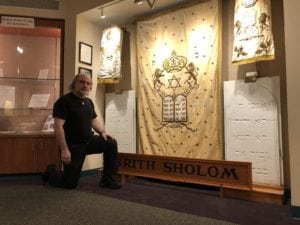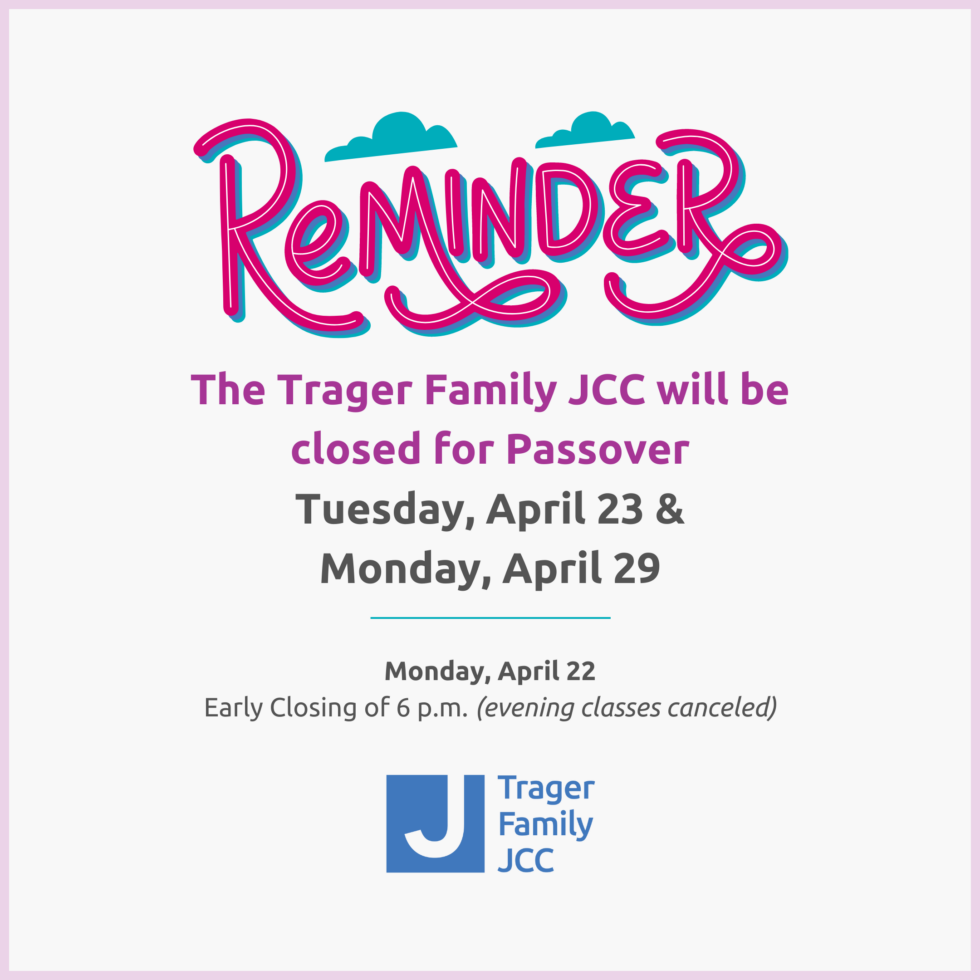
Rabbi Joe Rooks Rapport is pictured here with artifacts from the old Brith Sholom building in the archive of The Temple, which is celebrating its 175th anniversary this year. Rapport said The Temple, which regularly showcases its historic artifacts, is putting even more on display this year to mark the congregation’s history, tradition and notable figures through the years. (Community photo by Lee Chottiner)
As the members of Adath Israel were about to consecrate their first synagogue in 1848, on Fourth Street, not everyone was happy.
Some proclaimed the synagogue – the first built in Kentucky – as one of the most beautiful buildings in Louisville. Others dismissed it as an “awful barn.”
Few people, though, were as upset as I. Wolf, who didn’t like the fact that a melodion (small organ) was installed in the synagogue for the dedication.
According to minutes from one congregational meeting, Wolf was fined for using “intemperate language.”
In other words, according to Rabbi Joe Rooks Rapport, “he threatened to burn the building down if they didn’t get that BLANK organ out.”
The synagogue was consecrated – without the organ – though the congregation finally installed one 10 years later.
Rapport thinks the story encapsulates the nature of The Temple, the descendant congregation of Adath Israel and of Brith Sholom, which is celebrating its 175th anniversary this year.
“From our beginning, we’ve always been moving to liturgical and musical reform,” said Rapport, citing as evidence the introduction of the organ – something traditional synagogues of that time didn’t have.
But, Rapport added, “we’ve always worked things out.”
That religious balancing act has continued down through the years. Adath Israel became a founding member of the Union of American Hebrew Congregations (now known as the Union for Reform Judaism), and the first to use Minhag America, the movement’s earliest prayer book, in its worship services.
The founders of Brith Shalom in 1880, German Jews more recently arrived in America, wanted a synagogue where they could worship in German and wear their bowlers to services. Services at Adath Israel, by that time, were in English.
And when the two congregations “consolidated” in 1977 (to this day, they do not use the word merger) to form The Temple, the presidents of Adath Israel and Brith Sholom continued to serve until the end of their terms – two years. Then the new congregation elected a new president.
The transition was complete, said Jay Waldman, a member of the 175th anniversary committee, and a past president of The Temple.
“I grew up in Brith Sholom,” Waldman said, “but this is where I go, and that’s just all there is to it.”
The Temple is marking its milestone anniversary this year with a series of activities that celebrate its past while looking to the future.
In fact, the observances began in January with the Founders Day Shabbat, which marks the date the Adath Israel charter was signed by the governor, on January 12, 1843.
Activities will continue March 23 with the Isaac Mayer Wise Shabbat, which marks the birthday of the founder of Reform Judaism in America and a pivotal player in the history of the congregation. (He was offered the pulpit here.) A historic classical Reform service is planned as well as an archival display paying homage to the history of the congregation.
The anniversary committee also is planning to set up a photo gallery in the atrium, showcasing all 16 ordained rabbis who have served the congregation, said Lori Holland, chair of the anniversary committee.
Finally, the main celebration will take place the weekend of May 12. Plans are still being made, but one of the highlights will be the burning of The Temple’s mortgage.
The theme of the weekend will be Temple Generations, said Holland. Families with two or three generations in the congregation will be encouraged to attend, and children will parade with flags saying “175th.”
“We’re trying to have young people understand that the generations are so important,” Holland said.
The main celebration will be Saturday night. An evening of dinner, music and dancing will be tied together by a slide show, titled Temple Generations, which is being produced to showcase Temple members who can trace their families back the founders.
Holland said about 20 current members have ancestors who were founders.
“In today’s world, people move away and don’t come back,” she said, “so it’s exciting and it’s why the notion of generations is so critical to emphasize.”
The results of the Secure Our Future capital campaign also will be announced. So far, according to Waldman, $3.5 million has been raised toward the campaign’s goal of $5 million, giving financial security to the congregation.
“If we don’t spend foolishly,” Waldman said, “we’ll be around for a long time.”
Rapport clearly has become the resident historian of The Temple, answering questions about its history in the archive. It’s more like a museum, the repository for the congregation’s DNA.
Letters penned by Louis Brandeis hang on the wall, artifacts from the old buildings, such as a marble set of Ten Commandments from Brith Shalom sit on the floor, and 15 Torahs, including many from southern synagogues that have closed and two Holocaust scrolls, are housed in this room,
There are displays of historic artifacts from the history of the congregation, and even the Reform movement itself.
One item under glass is the silver mortar trough used to lay the cornerstone of the Plum Street Temple in Cincinnati – a gift from an old member.
Asked why the trough is here instead of Cincinnati, where the Rauh American Jewish Archives is based, Rapport quipped that he will gladly send it there when they send to Louisville the remains of Isaac Mayer Wise.
He loves to talk about historical figures who populate the congregation’s history: B. H. Gotthelf, for instance, the first hazen (spiritual leader) of the congregation, and Abraham Tandler the first parnas (president).
Back then, presidents wielded considerably more power than they do today. Tandler could require members to attend services or funerals. He could even fine them 25 cents if they did not or for other infractions, such as keeping their businesses open on Shabbat.
One thing that has remained constant throughout the history of The Temple and its antecedents, has been its commitment to social action.
At the time of its founding, members formed a Hebrew Benevolent Society. They sent money to New Orleans to combat a yellow fever epidemic, and to Sir Moses Montefiore to support the Jewish community in Jerusalem.
Members also played roles in the national affairs of the community. Gottheld, for instance, became the first interfaith chaplain in the Union Army during the Civil War, and only the second Jewish chaplain.
When the Titanic went down in 1912, there were several Louisvillians aboard, Rapport said. The Adath Israel rabbi at the time, H.G. Enelow, officiated at the memorial service.
The social action continues through interfaith efforts with Christians, Muslims and other faiths, support for the LGBTQ community and Rabbi Gaylia R. Rooks’ work for Crusade for Children.
Another constant is its people. Many members today are descendants of the founders.
Next year, Rapport noted, one his confirmands will be Emily Waterman, who just happens to represent the seventh generation of her family at The Temple. In any given year, this is true.
“A lot of the history of this congregation really isn’t history, Rapport said. “It’s family.”



